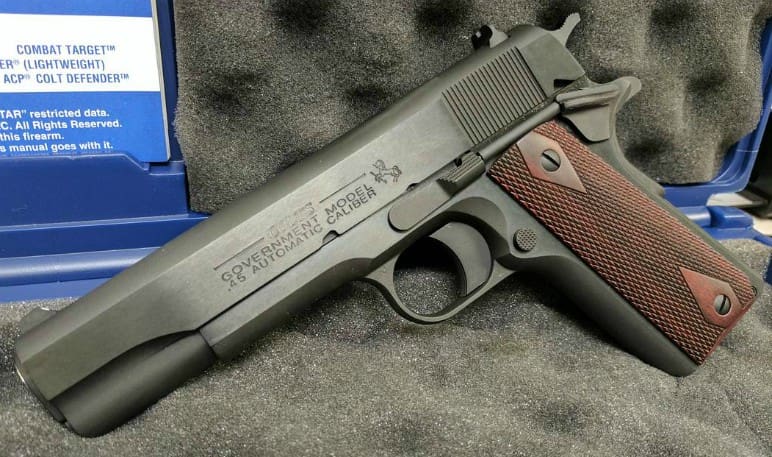
On March 29, 1911, Lt. Col. John T. Thompson of the U.S. Ordnance Department sent a letter to Colt’s in Hartford, Connecticut. The purpose was to inform them that the military testing held at Springfield Armory just two weeks prior had concluded and John Moses Browning’s 1911 design produced by Colt had come out on top.
Just like that, a legend was born. The M1911 served as the standard sidearm for American soldiers for the next 74 years.
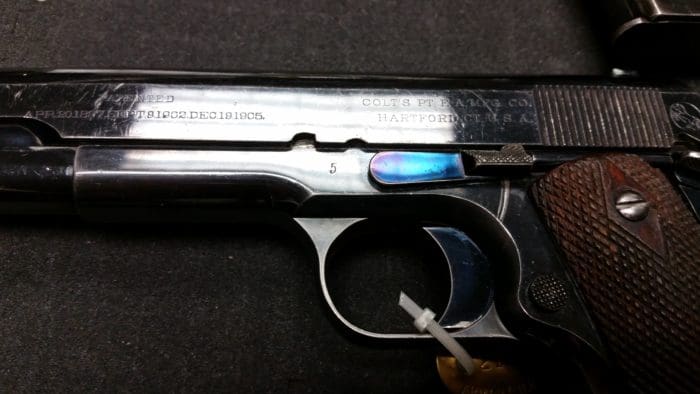
In the decades following the gun’s rise to fame, dozens of companies have put their own spin on the platform, but there’s an allure that still surrounds the pistols made by Colt.
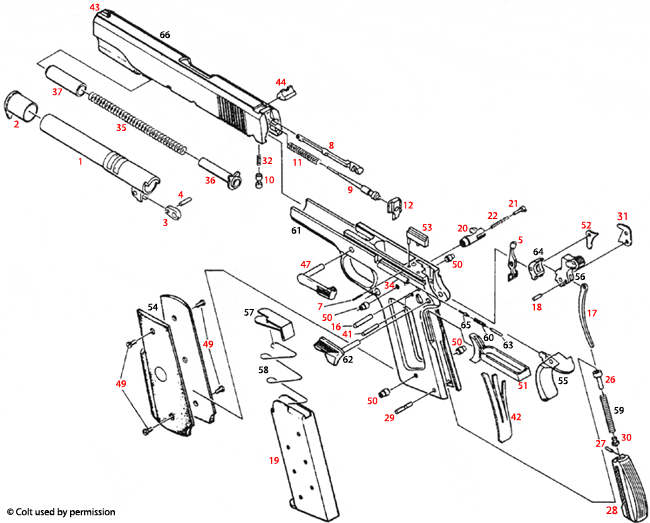
The gun up for review is a newly-manufactured Colt 1911 Government Model. Plenty of reviews are done for 1911s from all kinds of manufacturers, but we don’t seem to see as many honest-to-goodness Colts put through their paces.
Many a keystroke has been dedicated to the differences between the Colt Series 70 and Series 80 pistols. I’ve shot both and like them both. While Colt has reintroduced the Series 70, the gun reviewed here is a Series 80 model, which has an MSRP that is $100 less than the Series 70.
Unboxing
The Colt Series 80 is an eye-catcher, right out of the box. No, it doesn’t boast a luxurious, polished blue sheen, but it does have a clean, almost black finish to it. The entire gun, all the way down to the grip screw heads, has the same uniform finish. It’s a good-looking gun, classic to be sure with cues taken from the original including the spur hammer, solid trigger and non-flared ejection port.
The fit between the slide and the frame is excellent. Unlike the stories you hear of pistols that literally rattled in the hands of GIs in WWII, this gun makes no such sound.
Each pistol ships with two, seven-round flush magazines, both bearing the company name and the Rampant Colt on the floorplate.
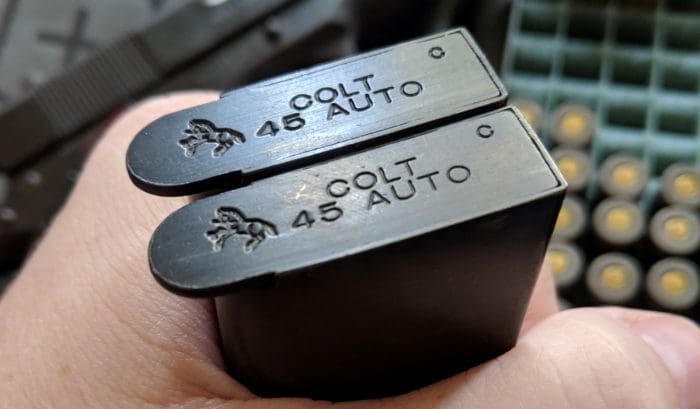
At the Range
The 1911 is a fundamentally uncomplicated gun. Insert a mag, release the slide, and hammer away until the single-stack magazine is empty. It’s that simple. The 1911 was designed to go bang when you need it to, and it does that extremely well.
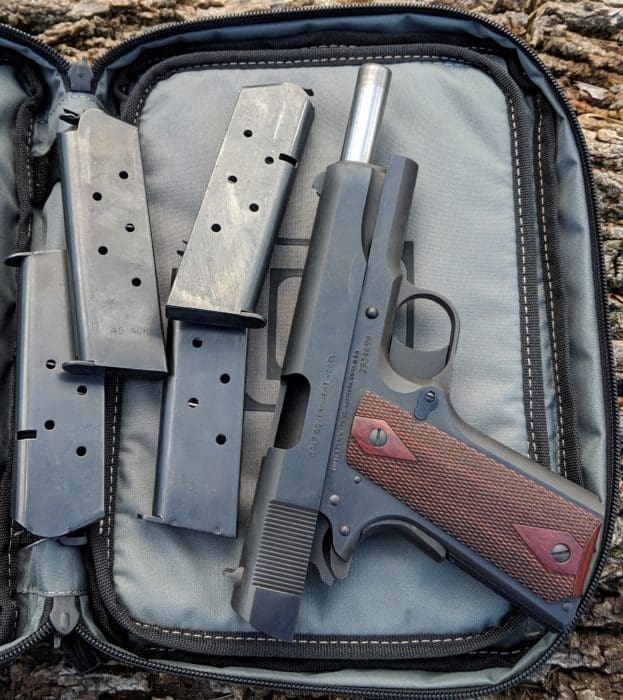
Based as it is on the original military design, this new Colt 1911 is very much a no-frills gun. The almost-black bluing I mentioned previously has a bit of a shine to it on the sides of the slide and frame. The top of the slide, however, has a matte finish. This cuts down on glare when you’re aiming the gun in bright sunlight, which is certainly appreciated.
The sights are simple, too; just your standard three white dots. Two on the rear sight and one on the front. It’s an arrangement that’s worked for decades and continue to do so.
I had LASIK last year, so it’s easy for me to pick up the sights and get them lined up on the target. If you’ve got older or less sharp eyes, you may find yourself wanting something a little bigger or brighter.
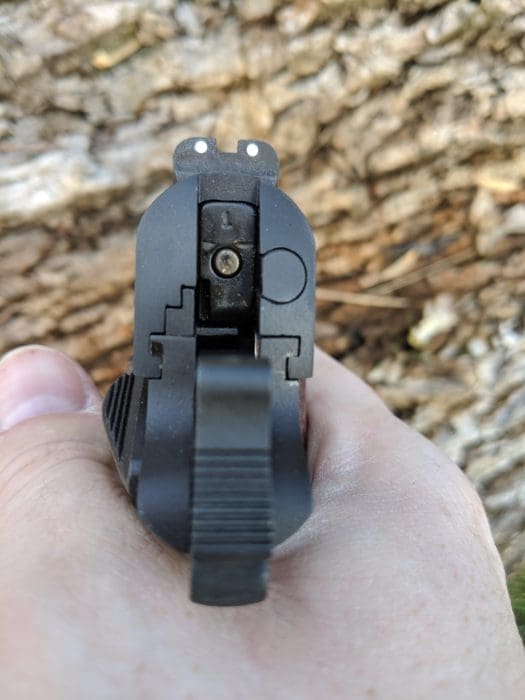
The traditional single action trigger isn’t anything fancy. It’s got a very noticeable take-up before you hit the wall – and hit it you do. Once that wall is reached, though, there’s no stacking or creep to be felt. Steady trigger pressure results in a very crisp break.
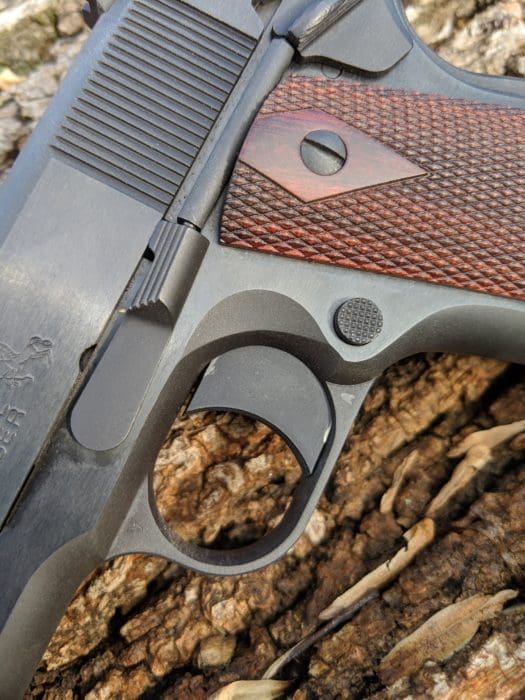
Some people say the trigger-actuated firing pin block on these guns makes for a trigger pull that’s anything but smooth and crisp. I disagree. My particular gun felt no different to my trigger finger than when I’m shooting a Series 70. YMMV.
Performance
This is a 1911, after all. That means the gun is heavy, weighing in at more than two pounds empty. It fires the .45 ACP cartridge as God and JMB intended. The .45 ACP, regardless of what anyone will tell you, is a harder-hitting round than the 9mm and that difference can certainly be felt when shooting a 1911.
That said, it’s far from an inaccurate gun. If you’re used to shooting 9mm, it might take a little getting used to when you start shooting .45 ACP. Once you get the hang of it, putting shots on target is just as easy.
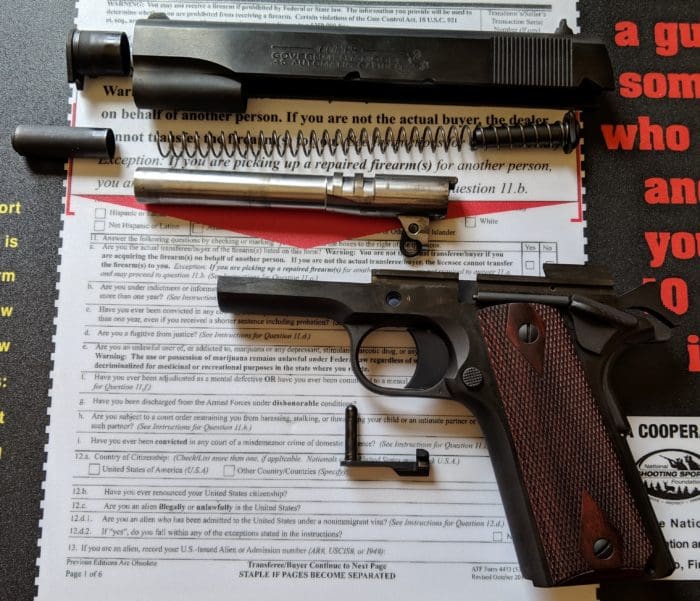
Since the 1911 semi-automatic pistol was designed to be used in combat, it’s the quintessential self-defense handgun, so that’s the distance at which I chose to do most of my testing.
At 21 feet, I was getting groups that averaged 1.5” overall. Some better, some worse, but a 1.5” grouping is shown here inside a 3” circle. Definitely good enough for government (model) work.

The gun ran flawlessly on a diet of various bullet weights and compositions. As long as you don’t have a limp wrist, the 1911 will go bang each and every time you pull the trigger.
You will find fancier 1911s and you will find less expensive 1911s. But there’s something to be said for having an affordably priced (about $750 retail) original Colt Government model that’s not much different from the one your grandfather had on his hip when he was in the army.
Specifications: Colt 1911 Government Model
Action: Single Action Hammer Fired Semi-Auto
Caliber: .45 ACP
Barrel Length: 5 inches
Capacity: 7+1
Safety: Thumb Safety, Grip Safety, Firing Pin Safety
Grips: Double Diamond Rosewood
Sights: 3-Dot
Weight: 35 oz
Frame Finish: Blued
Features: Service Hammer/ Long Trigger
MSRP: $799
Ratings (out of five stars):
Reliability * * * * *
There’s a reason the 1911 holds the record for the longest-serving sidearm of the American military. The design just works. Simple as that.
Ergonomics * * * *
A 1911 is a whole lot of gun in terms of weight. It’s well-balanced and points easily, but the size and weight can be a bit much for some shooters.
Customize This * * * * *
The platform wasn’t designed with customization in mind. There are thousands of ways to change this gun if that’s what you want. You can invest time and money and make this into a BBQ gun, but why would you do that to a standard government model like this? If you’re looking for a gun that lets you change out so many aspects of it that the final product is hard to tell exactly what you started with, buy a GLOCK.
Aesthetics * * * *
Most people say the M1911 is an elegant gun, due to its flowing lines and overall clean appearance from the mainspring housing to the barrel bushing. For a gun that was designed to win wars and save lives, the focus wasn’t on making a pretty pistol, but Browning succeeded in doing just that whether he intended to or not.
Overall * * * * *
It’s a Colt 1911. Sure, it doesn’t have the fit and finish of one made by Cabot or Wilson Combat, but that’s not the point of this model. This is a Colt 1911, and that says everything that needs to be said.
Logan Metesh is a firearms historian and consultant who runs High Caliber History LLC. Click here for a free 3-page download with tips about caring for your antique and collectible firearms.


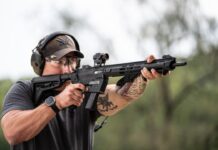


1) What happened to the Beretta review that was on Twitter but taken down quickly
and
2) Why the change from Freedom Ammunition? There was a lot of hoorah over that partnership and then it seems to have evaporated.
3) 1911 – 1,911 times better than a Glock !
1) That review was published accidentally. Look for it tomorrow.
2) Freedom Munitions had some financial difficulties and ended that arrangement.
https://www.thetruthaboutguns.com/2018/06/daniel-zimmerman/freedom-munitions-parent-files-for-bankruptcy/
3) I’m not touching that with a 10-foot pole.
Excellent answers all the way around. 😉
🤠
I must’ve missed the story a while back.
What company actually makes this 1911? I know it has COLT stamped on it, and Rock Island could as well make this gun as Kahr or Taurus. No pun intended.
I noticed that Colt has extended the grip safety enough to prevent hammer bite. Nice looking gun! It is a shame that Colt has been mis-managed for so long.
I’ve owned a lot of guns in my life, and still do. And I’ve carried and used a lot of guns in every legal way conceivable running the gamut from EDC, USPSA, fun, and 2 1/2 years in Iraq as a USG security contractor (during which I carried High Powers, Glocks, and Kimber 1911’s). The 1911 is and will ever remain the quintessential American sidearm. My first pistol was a 1911, and my wife and I each own and shoot one today (a Commander for me and a Government Model for her). Neither my wife nor I carry a 1911 as out EDC for our own reasons, but I hope the day will never come when I don’t have at least one 1911 in my personal collection. And Colt still makes a magnificent 1911.
I hope this release is an indicator that Colt will turn back to providing guns for the citizen rather than relying on USG contracts.
Judging by their return of the snake series it seems like they’ve realized this and are trying to return to their roots. It may be too little too late. Guess we’ll see.
I sure hope they get started with the Colt Python at an affordable price. That would be awesome.
Sorry. If the price is affordable, it is not a Python. When I was buying them in the ’70s, so far as I could tell they were the most expensive standard handguns in the world.Yeah, that was, like, $160 per, but still … A Model 19 S&W was $120, so was a Detective Special.
Define “affordable.”
If your definition of “affordable” is less than $2500… I don’t think you’ll be seeing a “real” Python anytime soon.
The new cobra line is apparently pretty solid from what’s been reported here, and is quite affordable. A new python would be more expensive, but I think that shows that Colt knows it’s going to have to play the price game just like everybody else. That’s the true glory of capitalism, and why it’s so much better then whatever the hell the left thinks it wants.
They can’t do both Matt. Either Python or affordable? You choose.
Colt has invested in all new CNC milling machines to produce their 1911s. (Which is why they are considered “new” guns by the State of California and no longer available for sale except by person to person transfer.) This should result in a well made gun without any hand fitting.
I honestly don’t know where this idea got started that “CNC = same as hand-fit” but I’m here to tell you it is without factual basis.
My knowledge is less than it should be, but i was told by various people/sources/myths/urban legends over the years that the series 70 was the one you wanted. That the series 80 had quality control issues. I really have no idea if true or not.
Can someone comment on that?
To be fair I own a Springfield 1911 manufactured around 1994? or so and carried a gov’t model in the Army until they switched to the Berettas.
The series 80 has the trigger doing more work to disengage a superfluous safety. 70 all the way or next best is a spacer setup/mod.
They have produced a number of fixes for that.
I run a TJs conversion shim in my Colt, it allows you to remove the unnecessary parts.
I know some used to run the Schwartz conversion on their pistols, they seemed to like it.
Got a buddy who likes his Strike Industries grip safety lever, that removes the duty of unlocking the firing pin from the trigger to the grip safety.
All of these will improve your trigger pull, however I believe the majority of shooters can’t tell the difference anyway.
A safety is not ‘superfluous’ if, without it, your gun can shoot you in the head if you negligently drop it.
Unless, of course, your head is ‘superfluous,’ in which case a Series 70 will suit you well.
LOL, damn John. I was to understand that particular safety prevents the firing pin from hitting the primer if the gun lands muzzle down. I’ll avoid handstands with poor retention holsters and I think that’ll keep my head bullet free. At least from that one particular scenario this safety seems to address. You sound like my 10th grade metal shop teacher. “God Damn punks are screwing around too much!”
As Broke_It NB’s, the 80 has more “stuff” getting pushed around by the trigger, with spring returns. So the trigger on the Series 80’s doesn’t feel as “crisp” and “uniform” as the 70’s trigger.
That said, you can eliminate some of this “mushiness” in the take-up by using Series 80 firing pin lock parts that have been nitrided. Several outfits make these parts kits – I like the ones from Cylinder & Slide.
The Series 80 changes were mostly a solution in search of a problem. If you have a Series 70, pre-WWII or Government model 1911 and you’re worried about it being drop-safe, get one of the low-mass firing pins and appropriate spring for it, slip these into your slide and keep the original ones.
The gun was invented, as I understand it, to pass California’s drop safe testing. Which it does. Or did until the microstamping requirement came along.
The trigger is different but I could never see a difference in “shootability”.
The 70 series may have an edge in bullseye competition but in action shooting, I think it is moot.
And even if there is a difference, a crappy 1911 trigger is leagues ahead of a Glock trigger.
I would have to agree with you there. It’s a difference noticed at a range poking holes in paper on my own time. Adrenaline fueled mag dumps under real duress renders the smoothness of any trigger a moot point.
Indeed. Slap it like your life depended on it.
I am one of those to love both modern polymer handguns and 1911s.
I too just enjoy guns because… guns.
I love ’em all!
Me too as well, also.
Finally, the review we’ve all been waiting for.
Carried (a likely WWII survivor) 1911 for the first half of my Marine Corps career, (instructing on it and competing with it) before changing over to the M9. Then in my second life I carried a brand new 1911, Combat Elite, (and then various other 1911’s) for nearly half of my career as a Police Officer before choosing to switch to the Glock 21 for extended capacity. I found the transition remarkably easy (many didn’t) and learned to love the Glock, and do to this day. That being said, I have and always will tell anyone within earshot that the Colt 1911 IS, AND FOREVER WILL BE, my favorite gun to carry or shoot, and in my experienced life have found nothing that is universally superior.
God Bless JMB and God Bless the USA!!
I met a Marine vet who served in SEA during the late 60’s. Upon hearing that I was a gunsmith, he asked me a very direct question:
“What, in your opinion, is the single best handgun ever made?”
Taking note of his USMC awards and pictures on the wall of his law office, I replied: “There are many good pistol designs out there, but I have to give my vote to the 1911.”
Turns out that was the correct answer. 😉
It also came out that he volunteered in Vietnam to go down into tunnels after Charles with nothing but a flashlight, a 1911, and some magazines. He said that when he needed it, the 1911 never failed him. As far as he was concerned, there will never be a better handgun – because when he needed it most, the 1911 was there, it worked, and it settled “disagreements” quickly.
It’s a Colt, it’s a 1911, it’s $800. A darned good deal if you ask me. …as far as the double tap accurate, I do better with 1911 in .45 acp then anything else. For me the slide moving back into battery seems to bring the sights right back on target. 9mm’s don’t seem do do this for me.
I don,t know much about the 1911 I have one I got a few years ago its a S,S,series 80 Colt MKIV gold cup national match that the safety has been changed and it does not have the regular guide in it that screws together I don,t know why it was that way when I got it but it is a shooter just like all of them heavy to us as a EDC with 1 in the pipe and seven in mag. maybe somebody out there can give me some info
Over the christmas break I had a 1911, not A1, marked US Property on the frame that had been made in 1916. I like the feel of the grip on the 1911 style pistols. Always have. I would just hate to have to get into an all new caliber and support system.
At the same time as the 1911 I was also invited to fondle a ww2 era nazi marked Luger and 1920’s era commercial Luger in .30 caliber. These old times just have such a solid feel to them. They feel like a ‘real’ gun. Something that my new glock doesn’t have.
I know what you mean. My Father in law had a Navy marked 1911 in pristine condition.
It was the smoothest 1911 I have ever shot. Like glass.
Kind of like my prewar Smith revolvers, all that hand fitting does not go un-noticed.
Just a quick comment for folks to understand the big differences between the Series 70 and 80 pistols.
Please look at the exploded parts diagram that Colt generously provided for Logan to use above.
There are two parts added to the slide, parts 32 and 10. 32 should be a spring, and 10 is a plunger that “captures” the firing pin and must be pushed up into the slide to allow the firing pin (9) to move forward. The firing pin (9) is different than the 70’s or other firing pins, because it has a little radius cut into it to be captured by the firing pin block (10).
OK, the firing pin block (10) is pushed up into the slide by the two pieces that are convert the rearwards motion of the trigger’s (51) stirrup to an upwards motion. These two pieces are 52 and 31.
That’s the biggest change from the 70 to 80 right there. There were two other issue of change in the Series 80’s. The first was the phase-out of the collet barrel bushing. If you do a web search for “1911 collet barrel bushing” you’ll see what that looked like. It was a clever idea on how to improve the accuracy (precision) of the 1911 without extensive gunsmithing and reliability-limiting tightening. Unfortunately, the early 70’s with the collet bushing had a rep for breakage. Colt improved the bushing finger thickness in the 70’s, but they phased out the collet barrel bushing early in the Series 80 pistol production.
The second issue was the change of the “hook” half-cock hammer position to a “ledge” on the hammer. The idea was that a “hook” on the hammer could result in the hammer or sear being seriously broken when someone was in a hurry and wanted that hammer to go down, whereas a sear on a ledge being forced down might just abrade the sear edge, but the gun would still be usable.
There might be other, less important issues between the 70’s and 80’s, but I’d have to go back to my books to find them all. From my perspective as a ‘smith, those are the changes/issues I hear the most about in customer 1911’s.
One other thing:
Look at the polish job on the 1911, Serial Number 5 pictured there.
An open note to Colt’s management:
If Colt really wants to win back us old farts who are willing to spend enough on a single gun that our spouses shriek and ask “You spent WHAT on WHAT?!”, you’ll get some real craftsmen back into the factory, get them in front of the polishing wheels, and you’ll start putting out some guns with the level of polish and finish on them from Serial Number 5 again.
At that point, I will open my wallet, and cash will vomit forth from it into your hands.
I always favored a Govt Slide on a lightweight frame with an officer’s model grips safety and commander hammer.
They are dandy, accurate guns when made of quality parts with some decent finishing. Springfield made a nice one but that is neither here nor there anymore.
Too bad Colt has been out of business for years. Maybe someone will buy them out and bring back the brand.
Who owns Colt? Bring back the brand? Colt makes some pretty nice stuff nowadays. Better quality now than 15 years ago by far.
I was being somewhat facetious…… Somewhat.
They seems to be trying but they haven’t shown up in years.
They have a long row to hoe.
IMO, the problem with series 80 isnkt that the trigger is worse due to the firing pin safety plunger. It’s that the that damn plunger makes it difficult to reassemble after detail-stripping the gun for cleaning.
i love my 1911s, but they take way more time to properly clean than my Glock 17 Gen 5 or Ruger LCP 2 and EC9s.
You have to CLEAN Glocks and LCPs!?
Dammit.
They’re dishwasher safe, right? That was the main reason I went with a glock.
Oh…well I’m good then.
The series 80 is what you want if you keep your gun at home chambered with the hammer down.
Amen!
I like my older Colt 1911’s and I also have a Shield, a full sized M&P, some XDM’s, a Springfield 1911 clone and a couple of Sigs in 45. It’s my favorite caliber.
The series 80 is ok, but the series 70 rocks. The series 70 is a little more expensive but well worth the difference. I still shoot my grandfather’s decades old “pimped up” and customized for international and Olympic competition vintage Colt 1911 with Clark slide and barrel, but decided to buy a new Series 70 to minimize beating up the heirloom and I am glad I did. I love my new Colt Government 1911 Series 70, it is not my grandfather’s 1911, but it is the best off the shelf alternative for those who appreciate the history of pistols. I own my share of Tupperware, but I love my Colts.
I’ve owned and shot a lot of 1911s. From high end to low end. My favorite of the bunch?
The Rock Island Tac Ultra, full size .45 ACP.
I can’t explain why – but I just loved it from the heft to the way it shot to the accuracy. I guess I can explain why.
The finish was rough. Like, horrible. But it was a flawless gun meant to get shot. And it got shot an awful lot.
Series 80 Suck! a thousand dollar cure for a rare problem, a ($10) cure works really well!
Colt abandoned the consumer public by chasing the big bucks of the Government, which they did for many years until they started turning out junk and the Government dropped them like a hot rock! Poor colt now remembers its public market, well personally I wish them luck as they have not had a winning strategy with the crap they put out.
The series 80 model 1991 Government does not suck. It and the series 70 Government are of equal quality. Go on youtube and see. I want a drop safe gun. And, I want to be able to store it at home with the chamber loaded and the hammer down. It is safe to do this with the 80 because of the firing pin block. No decocker but once the hammer is down the gun will not fire from being dropped.
Having owned a full-size Series 70 (and kicking myself for trading it) and an Officer’s Series 80, I agree with the reviewer that the Series 80 trigger is no impediment to superb accuracy.
I am considering small single action 1911 style handguns for carry. I consider the striker fired handguns cocked and unlocked even if the pull of the trigger has to complete the cock. Still too light of a trigger pull.
I want to carry the small 1911 with the hammer down. It means I have to cock it before it can fire. I am willing to take that extra step. It is safer to carry a chambered 1911 with the hammer down if it has a firing pin safety.
Well, what you need then is a DA/SA, not trying to carry a 1911 in Condition 2.
Himmm. I never thought of that. It makes sense. Thanks.
I’ve had a series 80 1991 A1 Colt since the early 1990s. I left it stock for years, even competing with it briefly in IDPA. It had the best factory trigger of any auto most people who shot it had ever felt. People went on and in about it. It was a very nice trigger pull, but in latter years, when I removed the series 80 parts and put in a slide blank, along with a new trigger and bow which I spent considerable time hand fitting…well, now it has a trigger better than any I’ve ever felt on any handgun, period. I’m guessing I got lucky on the polishing on the internals from the get go, and now with thousands of rounds through it to polish, and the hand fit trigger, and no series 80 parts….it is heavenly.
I will admit the series 80 is a safer gun to handle if dropped but I always hated them. I prefer the original 1911 without the passive firing pin safety. Simple to take apart and less parts to wear out or malfunction. And yes I have had problems with 1911 pistols right from Colt even 50 years ago. I have had hammers follow down the slide, and firing pin stop plates fall down during recoil and then catch on the frame on the forward return of the slide. I have had recoil springs go bad at only 4,000 rounds. And that was long ago.
Today we have plastic parts in Colt 1911 guns, we have rough crudely made MIM cast parts and plastic front sights. Some people love them but not me. I quite buying new 1911 pistols years ago but not the older made ones. I like my WWI surplus 1911 gun made by Colt and my series 70 made in 1975 even though I had some problems with it. I would not buy anything Colt or Smith is making today especially Smith revolvers. I get sick even looking at Smiths 2 piece barrels with their burned in edm rifling which picks up fouling like crazy and their roughly made MIM cast internal parts. Even Marlin now makes junk as I saw one my buddy bought this year and his lever gun had a plastic follower that broke on the first 50 rounds fired out of it. What trash.
I won a Remington 1911 at a drawing and could not sell it fast enough. It had a cheap cast frame and they were so cheap that when they made it they only put a tritium front sight on it, the back rear sight only had painted dots. It put me in a rage just to look at it. I never even shot it and I had trouble selling it even though it was new in the box. No one would even look at it for over 2 months proving what people really think of Remington’s cast iron 1911’s.
Yes the good old days of reasonably priced high quality forged steel, high polished Colts, Smiths, and Brownings are long since gone forever and we are stuck with a sea of outrageously over priced and crudely made modern plastic, stamped sheet metal and cast iron trash on today’s market. They would not even make good door stops or boat anchors.
I was lucky enough to see the old time heyday of military surplus that was so low in price people often took 2 even 3 of them home every time they went to a gun show (which was often). Tons of low priced U.S. 1911’s, Lugers, Radom’s, Astra’s , Broom Handle Mausers, Webley’s, Walthers and the list makes one cry today to think of how affordable they all were. It was gun collectors heaven on earth and we loved every minute of it and some months spent ourselves broke buying up as many guns as we could carry home and then we joked “throw them on top of the ever growing pile”.
Colt Pythons by the way were everywhere. I took two home at one gun show brand new in the box for $260 each a blued 4 inch and 6 inch. The most accurate revolvers I ever had the privilege of owning and shooting. They really were out of this world. All gone extinct now forever never to be made again.
Today its “lets make it faster , lets make it cheaper” because the buying public today is so dumb they would not recognize a quality gun if the quality gun walked up and shot them in the foot. I am not being facetious. The oohs and ahhs over the latest plastic and stamped sheet metal trash guns makes me wonder if I am now living on another planet and perhaps talking to Klingons or Romulins.
I can remember my father going out into the desert and shooting round after round with his 1911, he swore by it( he was a firearms instructor in the Air Force) anyway I did lots of research before I bought my colt and could have bought any one of the other models on the market,I have shot hundreds of rounds through it in the past year without trouble, I think I’ll keep it.
like everything else, if you dont like it and you cant say anything good about it just shut tfu and buy something else. tired of all the bitchin and critcizing . there are those of us that have the series 80 and like them.all the while not criticizing anybodys choice of what they choose to spend their money on.
Thanks for the informative review. I’ve been fooling around with 1911’s of various types for almost 50 years now, and quality-wise, they have run the gamut from the sublime to the ridiculous. I can well remember some dark days when Colt made some new guns that were of very sloppy quality, and you were better off starting with an old Colt and making it what you wanted it to be.
But I’d like to say a word about my experience with newer production Colts like the one reviewed. I returned from a multi-year contract overseas in 2013, and having sold firearms that I could not take with me, I needed to re-build my battery of handguns. I started with a brand new Colt Commander 1991 no-frills pistol in stainless steel, .45 ACP, of 2014 production. It proved to be an excellent firearm and I noticed no problems with quality control of any kind. I left it absolutely stock, and shot one of the tightest groups with it that I’ve ever shot with a 1911, even compared to some of my competition days. It was a great pistol, and I sold it to a friend for what I paid for it. He still enjoys it.
Then I purchased one of the new Lightweight Commanders in .45 ACP, again brand new, recent production with the new double wound recoil spring system. Again, nothing but a positive experience, except in one respect. Colt had a problem with the blued 8 round magazines they supplied with the pistol, which they replaced for me at no charge. My younger brother was so taken with the gun that he pestered me until I let him have it. He loves it.
I’ve since purchased a 2016 production Combat Elite, and a Combat Commander in 2018. Both have been flawless, and I cannot really decide which one I like better. I don’t plan to let either of them go, and being a bit of a Commander kind of guy, I will probably try to grab a LW Commander in 9mm before they are all gone (since they have been discontinued), just to have one. Also, a bit off the subject, but I also purchased a brand new Colt LE 6920 M4 carbine in 2015, because that is what I was issued as a patrol rifle when I was working, and it looks like a pretty nice gun to me and shoots very well, doing everything I expect a defense carbine to do.
I see some people online complaining about current Colt quality, but save for the one issue with a couple of magazines not locking open on the last shot, I haven’t seen it yet in five purchases of new, recent production guns in the last five years. I hope my string of good luck continues with my next one. And I hope that Colt can get its financial act in order and will be with us for a long time.
I prefer the Series 70 and 1911’s made by other manufacturers which are faithful reproductions of the original John M. Browning design. The firing pin safety plunger, spring, and actuator (parts 32, 10, and 31) were not part of the original design and are not needed. In fact, the Series 80 guns have a trigger action which is inferior to the Series 70. As Dyspeptic Gunsmith has pointed out, one can simply add a low mass firing pin and an extra power firing pin spring to prevent a discharge in the unlikely event that the gun is dropped on a hard surface and falls on the muzzle.
If you love to wear vests? so get this amazing Red Puffer Vest which is a favorite of all girls and it is the most-rated and most selling outfit in our store, shop now because the stock is limited.
Comments are closed.